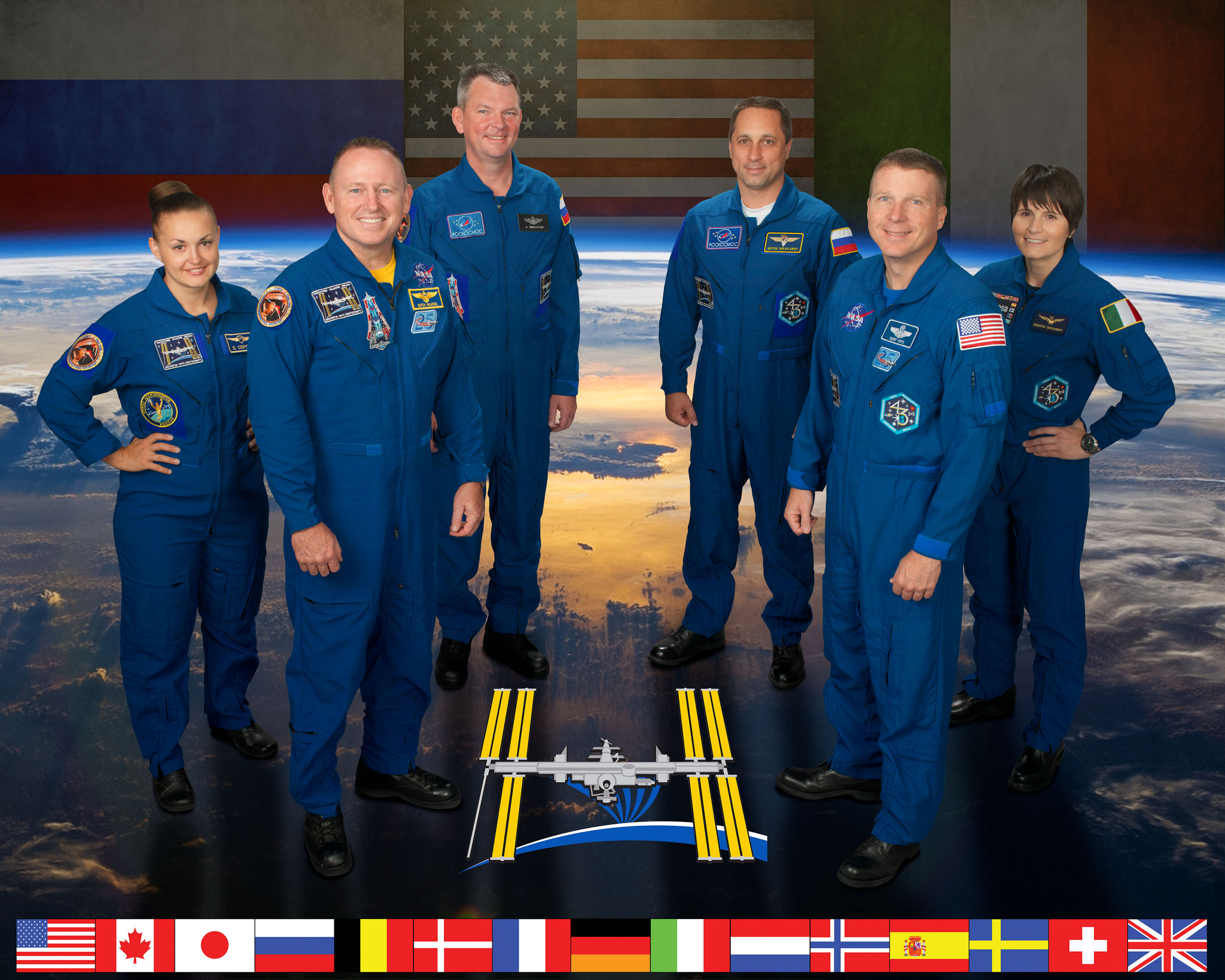
Two weeks after the 9 November return to Earth of Soyuz TMA-13M, a new three-member crew will launch from the Baikonur Cosmodrome in Kazakhstan at 3:01 a.m. local time Monday, 24 November (4:01 p.m. EST Sunday, 23 November), bound for a six-month stay aboard the International Space Station (ISS). Russian cosmonaut Anton Shkaplerov, U.S. astronaut Terry Virts, and Italy’s first female spacefarer, Samantha Cristoforetti, will embark on a now-standard six-hour, four-orbit “fast rendezvous” profile and should be in position to dock their Soyuz TMA-15M spacecraft at the station’s Earth-facing (or “nadir”) Rassvet module at 9:53 p.m. EST Sunday. After confirming the integrity of seals between the two vehicles, hatches will be opened at about 11:30 p.m., whereupon the new arrivals will be greeted by the incumbent Expedition 42 crew of U.S. astronaut Barry “Butch” Wilmore and Russian cosmonauts Aleksandr Samokutyayev and Yelena Serova, who have been aboard the orbital outpost since 25 September.
Making its 124th piloted flight since the ill-fated mission of Vladimir Komarov, way back in April 1967, the Soyuz spacecraft comprises three main segments: from the base, a cylindrical instrument and propulsion module, a bell-shaped descent module, and a spheroidal orbital module. Soyuz TMA-15M arrived at Baikonur in mid-August 2014 to commence pre-flight inspections, firstly in the Spacecraft Assembly and Testing Facility and subsequently in the vacuum chamber for leak checks and radio interference tests. On 13 November, it was loaded with approximately 1,760 pounds (800 kg) of unsymmetrical dimethyl hydrazine and nitrogen tetroxide propellants for its attitude-control and propulsion systems, together with helium pressurant and oxygen and nitrogen for its environmental controls. It was then transferred back to the Spacecraft Assembly and Testing Facility for final processing, ahead of integration with its mammoth Soyuz-FG booster. Over the next several days, it was encapsulated within its aerodynamic payload shroud and the State Commission met today (Thursday, 20 November), to review the status of the mission. Rollout of the vehicle to Site 31/6 at Baikonur is expected early Saturday.
Concurrently, the two groups of astronauts and cosmonauts assigned to Soyuz TMA-15M—the prime crew of Shkaplerov, Virts, and Cristoforetti and their backups, Russian cosmonaut Oleg Kononenko, U.S. astronaut Kjell Lindgren, and Japan’s Kimiya Yui—traveled from the Star City training center, on the forested outskirts of Moscow, to Baikonur, on 13 and 14 November, respectively. Reports indicated that the 24-hour delay in the arrival of the backup crew was caused by a problem with their aircraft. Upon disembarking, the crews were greeted by members of the State Commission and Technical Management, to whom the respective commanders, Shkaplerov and Kononenko, declared their readiness to fly. Although the arrival at Baikonur offered some time for relaxation, the two crews plunged directly into a final training phase, familiarized themselves with documentation, and performed fit-checks of their Sokol (“Falcon”) launch and entry suits and seat liners.
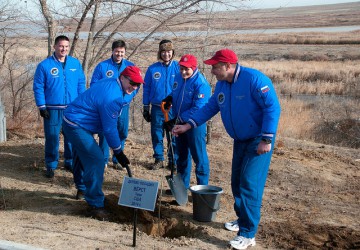
On Tuesday, 18 November, they participated in the customary tree-planting ceremony, a ritual followed by each spacegoing crew from Baikonur. “Today, Terry and I had some gardening to do,” Cristoforetti explained on her Facebook page. “Last time I planted a tree I was in fifth grade. Today, I was probably as happy as I was back then, as an 11-year-old. It is a great honor to have “my” tree in this alley, along with those planted by every human who ever left the Earth from Baikonur.” Next day, Wednesday, 19 November, the trio boarded Soyuz TMA-15M for the last time before it was integrated with the booster, and traditionally raised their respective national flags at Baikonur.
With liftoff targeted for early Monday, local time (late Sunday afternoon EST), Launch Day promises to be a long one for both the prime and backup crews of Soyuz TMA-15M. They will be awakened about 8.5 hours before the scheduled launch. They will shower and be disinfected, after which microbial samples will be taken in support of the scientific experiments to be undertaken in orbit. Breakfast will be followed by departure from Baikonur’s Cosmonaut Hotel and the traditional blessing by a Russian Orthodox priest. Shkaplerov, Virts, and Cristoforetti will then be bussed out to Site 254, where they will submit to final medical checks and don their Sokol suits. This will also offer them a final chance to speak, face-to-face, with their families, albeit from behind glass screens. The trio will then depart Site 254, bound for the launch pad.
Since March 2013, Russia has attempted to deliver its piloted Soyuz spacecraft to the ISS in just six hours, and four orbits of Earth, to alleviate pressure on the crew. Earlier missions typically followed a two-day rendezvous regime, which proved more economical in terms of propellant expenditure, but also tended to be highly cramped, stressful, and exacerbated nausea and motion sickness. First trialed by an unmanned Progress resupply craft in August 2012, the “fast rendezvous” was successfully executed by four Soyuz crews last year and would have been performed by Soyuz TMA-12M in March 2014, but for a malfunction shortly after orbital insertion. This forced the crew to revert to the standard two-day, 34-orbit approach profile, which was completed successfully.
“Same-day” rendezvous and docking are nothing new. In September 1966, Gemini XI astronauts Charles “Pete” Conrad and Dick Gordon accomplished a rendezvous and docking with an Agena target vehicle just 85 minutes and a single orbit after launch. Several years later, during the Skylab era, crews followed an expedited rendezvous lasting nine hours to reach their home in space. However, since the late 1970s, in the interests of propellant economy, most crews—including shuttle-Mir and ISS crews—spent between one and two days in transit, prior to docking.
At the launch pad, Shkaplerov, Virts, and Cristoforetti will be ensconced into their specially contoured seats aboard the Soyuz TMA-15M descent module about two hours before liftoff. Cristoforetti will take the Flight Engineer-1 position on the left side of the cabin, with Virts assuming the Flight Enginee-2 seat on the right side. Shortly afterwards, they will joined by Shkaplerov, who will assume the central commander’s couch. Their launch vehicle—a descendent of Chief Designer Sergei Korolev’s R-7 missile, an early variant of which carried Yuri Gagarin into space—will undergo final checks and will be fully fueled with a mixture of liquid oxygen and a refined form of rocket-grade kerosene (known as “RP-1”) by T-3 hours. After loading, the oxygen will enter a “topping mode,” whereby all cryogenic boil-off will be rapidly replenished until shortly before launch. This will ensure that all tanks remain at “Flight Ready” levels, prior to the ignition of the RD-108 engine of the first stage and the RD-107 engines of the four tapering, strap-on boosters.
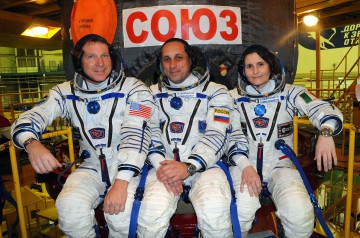
In the final 15 minutes, the Launch Abort System (LAS) will be armed and transferred to Automatic Mode, the crew will be instructed to close their visors and Shkaplerov’s controls will be activated. Internal avionics will be initiated and the on-board flight recorders will be spooled-up to monitor the Soyuz-FG’s myriad systems throughout ascent. Inside the control bunker, the “launch key”—an actual, physical key—will be inserted in order to enable the ordnance to support Soyuz TMA-15M on its voyage. This will be followed by the completion of nitrogen purging, the pressurization of the rocket’s propellant tanks and the continued topping of cryogens.
A minute before liftoff the Soyuz-FG will transfer to internal power, and at T-10 seconds the engine turbopumps will attain full speed. By five seconds, the engines of the core and tapering boosters will roar to life and quickly reach full power. This will produce a retraction of the fueling tower and a liftoff into the darkened Baikonur sky at 3:01:13 a.m. local time Monday, 24 November (4:01:13 p.m. EST Sunday, 23 November).
Rising rapidly, the rocket will exceed 1,100 mph (1,770 km/h), within a minute of clearing the tower, and at T+118 seconds the four tapering boosters will be jettisoned, leaving the core stage alone to continue the boost into low-Earth orbit. By the two-minute mark, Shkaplerov, Virts, and Cristoforetti will surpass 3,350 mph (5,390 km/h), and, shortly thereafter, the escape tower and launch shroud will separate, exposing Soyuz TMA-15M to the near-vacuum of the rarefied high atmosphere. Four minutes and 58 seconds after leaving the desolate steppe of Central Asia, the core booster will separate at an altitude of 105.6 statute miles (170 km) and the third and final stage will ignite, accelerating the Soyuz to a velocity of more than 13,420 mph (21,600 km/h). By the time the third stage separates, nine minutes into the flight, the crew will enter an orbit of about 125 x 160 miles (200 x 260 km), inclined 51.6 degrees to the equator, and will begin the process of deploying their craft’s communications and navigation antennas and solar arrays.
Four maneuvering “burns” will be required to raise the apogee of this orbit to reach the operational altitude of the ISS. The first burn (DV-1) should occur 45 minutes into the mission, after which a second burn (DV-2) is timed at 90 minutes after liftoff. These will be followed by another pair of burns, later in the rendezvous sequence, which should position Soyuz TMA-15M for an on-time docking at the space station’s Earth-facing (or “nadir”) Rassvet module at 9:53 p.m. EST Sunday, about five hours and 52 minutes into the flight. Following standard pressure and leak checks, the hatches will be opened and the trio will be greeted by the incumbent Expedition 42 crew of Commander Barry “Butch” Wilmore and his crewmates, Aleksandr Samokutyayev and Yelena Serova. At the time of the Soyuz TMA-15M docking, the ISS will also accommodate two unpiloted visiting craft: Russia’s Progress M-25M and Europe’s fifth and final Automated Transfer Vehicle (ATV-5).
The arrival of Shkaplerov, Virts, and Cristoforetti will restore the ISS to its full, six-person strength, through March 2015. The presence of two female crew members on Expedition 42—Italy’s Cristoforetti and Russia’s Serova—will make this the first occasion in history that a pair of women have been in space together over the Christmas and New Year periods. It is a minor record, perhaps, but with Cristoforetti also becoming the 59th female spacefarer and the first from Italy, it is surely an indicator that the presence of women in space is steadily being taken seriously by the International Partners. Since the pioneering mission of Valentina Tereshkova, back in June 1963, women from Russia, the United States, the United Kingdom, Canada, Japan, France, Iran, and China have ventured into orbit, 11 of whom have embarked on spacewalks. With the possibility of several EVAs during the Expedition 42/43 increment, there remains a distinct possibility that Cristoforetti may don a U.S.-built Extravehicular Mobility Unit (EMU) and perform work outside the ISS, which would make her the first non-U.S. and non-Russian female spacefarer in history to perform a spacewalk.
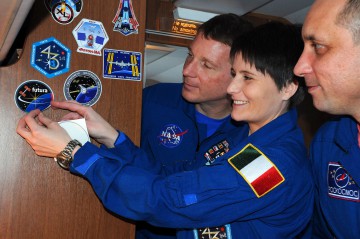
With Wilmore, Samokutyayev, and Serova expected to remain aboard the station until March, and Shkaplerov, Virts, and Cristoforetti anticipated to return to Earth in May, the impending joint mission promises to be a busy one, with scientific research, a handful of visiting vehicles, and several EVAs planned. Speaking in September 2014, Virts remarked that some 240 experiments—about 170 provided by the United States, including academic and commercial payloads, and 70 others by international scientists—will be undertaken in the U.S. Orbital Segment (USOS), whilst Shkaplerov added that his role in the Russian Orbital Segment (ROS) would encompass medical and biological studies, in addition to around 50 other investigations already in work aboard the ISS. “It would take a long time to list all the experiments,” he told an audience at the Johnson Space Center (JSC) in Houston, Texas.
“We have a very aggressive science program that we’re doing,” Virts explained. Yet several experiments do stand out for the three crew members. Virts, whose NASA biography lists astronomy as one of his interests, is particularly excited by the Alpha Magnetic Spectrometer (AMS)-2, mounted atop the space-facing (or “zenith”) side of the station’s S-3 truss structure, and by Japan’s Monitor of All-Sky X-ray Image (MAXI) experiment, affixed to the Kibo laboratory. Both Virts and Cristoforetti are interested in the investigations which focus upon the effect of microgravity on the human body, including bone loss, lung function, and visual acuity. “It makes me feel more like a scientist,” Cristoforetti said about working with hands-on experiments in the Microgravity Science Glovebox (MSG) inside the U.S. Destiny laboratory, although she pointed out that several investigations are autonomous or controlled remotely from the ground.
Both she and Virts have signed up for a European Space Agency (ESA) experiment on airway monitoring, which will require them to breathe a specialized gas mixture to better understand the performance of their lungs in space. Virts also noted that about 30 percent of shuttle-era astronauts experienced vision problems, which quickly corrected upon their return to Earth, but that approximately 60 percent of long-duration ISS crew members have suffered from degraded vision which has affected them in the lon. During his six months aboard the station, Virts will perform Optical Coherence Tomography (OCT) scans, fundoscopy, and will also take ultrasound measurements of his brain and heart, in order to monitor blood flow to his eyes. Bone loss experiments will also be performed, with Virts noting that regular exercise has helped crews—including the Expedition 40 team, who returned in September 2014, with a virtually insignificant 0.3 percent of bone tissue loss—to maintain their health and physical strength during lengthy missions.
Aside from the dedicated experiments, the crew has also trained extensively to handle unexpected medical contingencies, which Virts described as “a diverse job.” On his STS-130 shuttle flight, back in February 2010, the crew included a dedicated medical officer, but for ISS expeditions each member of the team has to assume the mantle of the scientist, the mechanic, the doctor, the sewage worker, the cook, and the cleaner. In readiness for their six months in space, Shkaplerov, Virts, and Cristoforetti received a level of training roughly equivalent to an Emergency Medical Technician (EMT), allowing them to deal with situations up to and including a heart attack. They learned how to take blood samples as part of their experiment training, but also undertook several shifts in a Houston emergency room and at a dental clinic. “It’s a part of training that we hope we’ll never have to use,” Virts said, but added that the ISS carries its own basic pharmacy and in the event of a major medical emergency their Soyuz TMA-15M spacecraft would be primed to bring the crew home at a few hours’ notice.
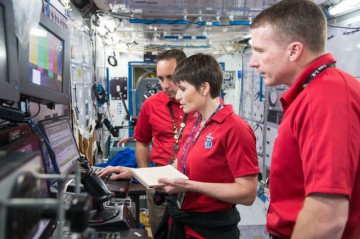
Thankfully, medical emergencies requiring crew members to be returned to Earth has proven an extreme rarity throughout the history of human space exploration. In the fall of 1985, Soviet cosmonaut Vladimir Vasyutin fell ill aboard the Salyut 7 space station, and although the precise nature of his ailment remains subject to conjecture, it seems that the microgravity environment did not suit him. Following his return to Earth, he spent time in a Moscow hospital and later blamed a battle with “inflammation” and “a high fever,” although his crewmates made reference to “anxiety in his behavior and loss of sleep and appetite,” as well as Vasyutin being in “pain” and described as “tense” and “a bundle of nerves.” Later, in the spring of 1987, cosmonaut Aleksandr Laveykin experienced a “rather painful” adaptation to spaceflight and later suffered “minor heart irregularities” which were of sufficient severity that he was returned to Earth in July, six months into a planned 11-month mission. A number of others, including Mongolia’s first man in space, Jügderdemidiin Gürragchaa in March 1981, appear to have adapted badly to the microgravity environment, although medical ethics mean that other cases will undoubtedly never be divulged.
The arrival of Shkaplerov, Virts, and Cristoforetti aboard the ISS will shortly be followed by their first unpiloted visitor, SpaceX’s fifth dedicated Dragon cargo craft (SpX-5), which currently has Eastern Range approval to fly from Space Launch Complex (SLC)-40 at Cape Canaveral Air Force Station, Fla., no earlier than mid-December. Marking the third Dragon mission of 2014—it follows SpX-3 in April-May and SpX-4 in September-October—this mission is part of a $1.6 billion Commercial Resupply Services (CRS) contract, signed between NASA and the Hawthorne, Calif.-based SpaceX, back in December 2008. It requires the company to fly 12 dedicated Dragons to deliver 44,000 pounds (20,000 kg) of equipment and critical supplies to the ISS crews by 2016.
Assuming an on-time launch, Dragon will rendezvous and be grappled by the station’s 57.7-foot-long (17.6-meter) Canadarm2 robotic arm about two days later and berthed at the Earth-facing (or “nadir”) port of the Harmony node. It is expected to remain in place until early January 2015, whereupon it will be loaded with items for return to Earth and robotically unberthed and released into space. The capsule will then descend to a parachute-assisted splashdown, off the California coast. Another Dragon (SpX-6) is currently scheduled to launch in early February and will follow a similar protocol, remaining at the ISS until the beginning of March. Other departures and arrivals with occur at the ROS, with Europe’s ATV-5 cargo ship expected to undock from the aft longitudinal port of the Zvezda module on 10 February and Russia’s Progress M-26M scheduled to take its place shortly thereafter on the 17th.
Meanwhile, Orbital Sciences Corp.—NASA’s other CRS partner, tasked with providing eight flights of its Cygnus cargo ship, under a $1.9 billion contract—was originally intended to launch its fourth dedicated mission (ORB-4) in April 2015. However, the catastrophic loss of ORB-3, just seconds after the launch of its Antares booster from Pad 0A at the Mid-Atlantic Regional Spaceport (MARS) on Wallops Island, Va., on 28 October, has potentially thrown these plans into disarray. Although Orbital has pledged that it will stand by its commitments to NASA, it is also clear that the Dulles, Va.-based company will likely not fly another Antares until the spring of 2016. This means that it may rely upon a different vehicle to deliver ORB-4 into space, and it is unclear at present if the April 2015 launch target remains viable.
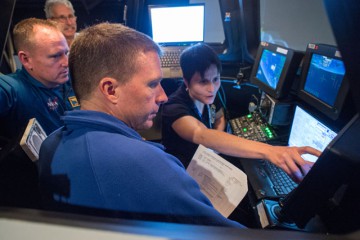
Also in the opening weeks of 2015, a pair of U.S. EVAs are planned to be conducted by Wilmore (EV1) and Virts (EV2) in the January-February timeframe. During a pre-flight press conference at JSC, last July, Wilmore explained that he and Virts would be “the cable guys,” responsible for routing umbilicals and utilities in readiness for the delivery and installation of two ISS Docking Adapters (IDAs) aboard the SpX-7 and SpX-8 Dragon missions in June and August 2015. Their arrival, together with the robotic relocation of the Leonardo Permanent Multipurpose Module (PMM) in late July, will support the dawn of Commercial Crew operations from 2017. Two months ago, Boeing and SpaceX were awarded contracts totaling $6.8 billion to develop their CST-100 and Dragon V2 vehicles to return U.S. astronauts to space from U.S. soil for the first time since the end of the shuttle era. In his recent Expedition 42/43 press conference, Virts added that another EVA task would tend to the aging Canadarm2, which was installed aboard the station by the STS-100 shuttle crew in April 2001. “This arm has been there for over ten years,” he explained, “and it’s getting a little sticky, so we’re going to have to go outside and put some grease on it.”
The “core” Expedition 42 crew of Wilmore, Samokutyayev, and Serova are expected to undock from the ISS in their Soyuz TMA-14M spacecraft on 12 March and return to Earth after 168 days in orbit. Wilmore will hand command of the station to Virts, who will lead the new Expedition 43 until mid-May. Two weeks later, on 27 March, the second half of Virts’ crew—Russian cosmonauts Gennadi Padalka and Mikhail Kornienko, together with U.S. astronaut Scott Kelly—will arrive aboard Soyuz TMA-16M. Of the new crew, Kelly and Kornienko will remain aboard the ISS until March 2016, becoming the first astronauts or cosmonauts since Sergei Avdeyev in 1998-1999 to spend a whole year, continuously, in orbit. They will also become the first pair of spacefarers to spend a year aloft since Vladimir Titov and Musa Manarov, way back in 1987-1988.
Another U.S. EVA in support of the reconfiguration of the USOS is currently planned for April 2015, almost certainly involving Virts and either Cristoforetti or Kelly. This means that Virts will potentially perform as many as three spacewalks during his increment, although he joked at his pre-flight press conference that many people had asked him how many EVAs he would make, “and I tell them, somewhere between zero and ten!” Unlike the shuttle era, where EVAs were planned and choreographed many months or years in advance, as an ISS expedition crewman, he is keenly aware that contingencies can arise and “you need to be able to tackle anything.” Present plans anticipate that Shkaplerov, Virts, and Cristoforetti will board their Soyuz TMA-15M spacecraft on 11 May, returning to Earth after approximately 169 days in orbit.
The second part of this article will appear tomorrow, focusing on the background and training of the crew.
Want to keep up-to-date with all things space? Be sure to “Like” AmericaSpace on Facebook and follow us on Twitter: @AmericaSpace
Missions » ISS » Soyuz TMA-M » Missions » ISS » Soyuz TMA-M » TMA-15M »


